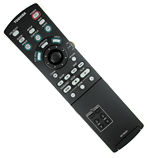Toshiba SD-6200 Progressive-Scan DVD Player Page 2
 Other niceties include the SD-6200's ability to pass PLUGE signals (some earlier Toshiba progressive players did not do this from the progressive outputs), which helps dial-in your monitor's brightness and adjustable black level (7.5 or 0 IRE). This is where I would usually go into the rap about how your TV has to have multiple picture-control sets to take advantage of an adjustable black level without readjusting for every source component, but the Toshiba has you covered with multiple picture-control memories of its own. (This may be moot, though, given that your TV will have to be fairly advanced to be compatible with progressive scanning anyway and probably has you covered here.) The SD-6200 also offers 4:4:4 color processing, which increases the sampling rate of the blue and red color information to match that of the luminance information (13.5 megahertz) for improved color reproduction, RTD video-noise reduction, and a twin-tray loading mechanism that allows the player to hold two discs.
Other niceties include the SD-6200's ability to pass PLUGE signals (some earlier Toshiba progressive players did not do this from the progressive outputs), which helps dial-in your monitor's brightness and adjustable black level (7.5 or 0 IRE). This is where I would usually go into the rap about how your TV has to have multiple picture-control sets to take advantage of an adjustable black level without readjusting for every source component, but the Toshiba has you covered with multiple picture-control memories of its own. (This may be moot, though, given that your TV will have to be fairly advanced to be compatible with progressive scanning anyway and probably has you covered here.) The SD-6200 also offers 4:4:4 color processing, which increases the sampling rate of the blue and red color information to match that of the luminance information (13.5 megahertz) for improved color reproduction, RTD video-noise reduction, and a twin-tray loading mechanism that allows the player to hold two discs.
Outputs include a single set of component video (with selectable interlaced or progressive output via the remote control), one each of S-video, composite video, coaxial digital audio, and optical digital audio, and the six analog outputs dedicated to the DD decoder. The button to switch between progressive or interlaced output from the component jacks is cryptically dubbed ColorStream Selector on the remote and hidden under the flip-down cover—although this is explained clearly in the manual. Similarly odd, the default setting for the component jacks on the player I reviewed was interlaced, so make sure you select progressive output before you get bitter about the fact that your new progressive player's picture looks just like your old interlaced unit. Needless to say, the default should have been progressive. These are, however, nothing more than nitpicks.
In running the SD-6200 through our standard battery of tests, I wasted no time with any Video Essentials patterns that relate to interlaced performance or any assessment of its ability to downconvert anamorphic transfers for display on 4:3 sets—why anyone would buy this player and use anything but the progressive component output and a 16:9 display (or the 16:9 mode on some of the new 4:3s) is beyond me. That aside, the SD-6200 hammered out a razor-sharp 500 lines of resolution (essentially the maximum amount possible), blacker-than-black information was delivered as promised, and color bandwidth was plenty healthy. Forward and reverse scanning and slow motion were relatively smooth and surprisingly stable.
OK, so I use Saving Private Ryan a lot, but I like to stick with what works, so bear with me. Besides, this movie is one that benefits considerably from progressive scanning. You'll never remove all of the choppiness from this film, and you shouldn't want to. It's not only intentional but powerfully thematic. What you can do, as the SD-6200 did beautifully, is smooth out unnatural jagged edges and greatly reduce the ghosting that this flick's lightning-quick transitions cause noticeably on interlaced players with no processing and even on outboard doublers that may not be proficient in their 3:2 pulldown techniques. This greatly enhances the sense of realism, which—with a powerful and jarringly lifelike movie like this—is undoubtedly a top priority.
To put this theory to the test, I took in the Omaha Beach scene three separate ways: once using the SD-6200's progressive outputs straight into the Toshiba CW34X92 direct-view set, once using the SD-6200's interlaced output and the TV's internal doubler, and once using the SD-6200's interlaced outputs going into our Faroudja DVP-2200 (one of the better video processors out there) and then to the television. The results were not surprising. Using only the CW34X92's internal doubler, which isn't bad as TV doublers go, resulted relatively consistently in the aforementioned ghosting and jagged borders. The picture was still solid; however, after catching your first inconsistency, you were keenly aware that you were watching a movie and not the real thing. The output of the Faroudja varied little from the output of the SD-6200's progressive feed, but I still favored the latter slightly, with its overall ability to reconcile the warmth and smoothness of film with the bleak color and jerky motion of this particular movie. Neither was perfect, obviously, and some might favor the Faroudja for their own reasons. Keep in mind, though, that the DVP-2200 will set you back a cool eight grand—so, even if we call it a draw in picture quality, the advantage lies firmly with the SD-6200 in price alone.
- Log in or register to post comments




































































